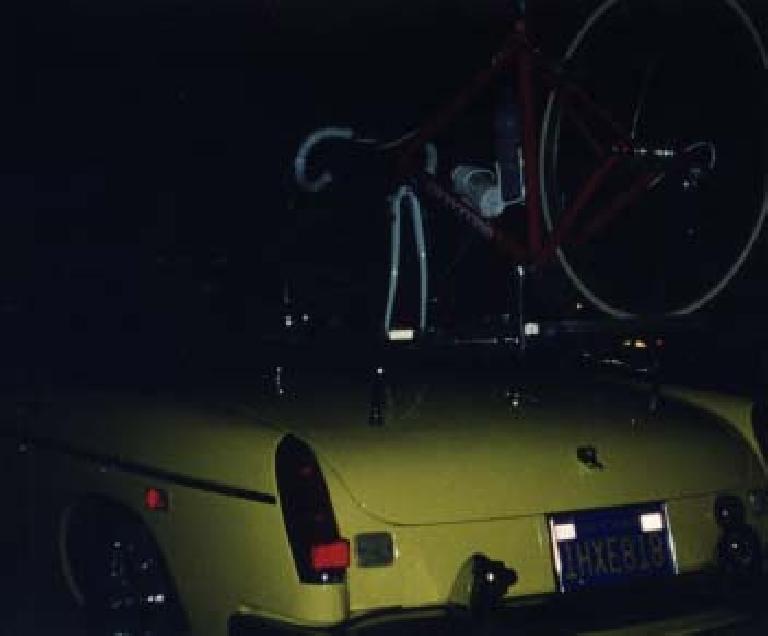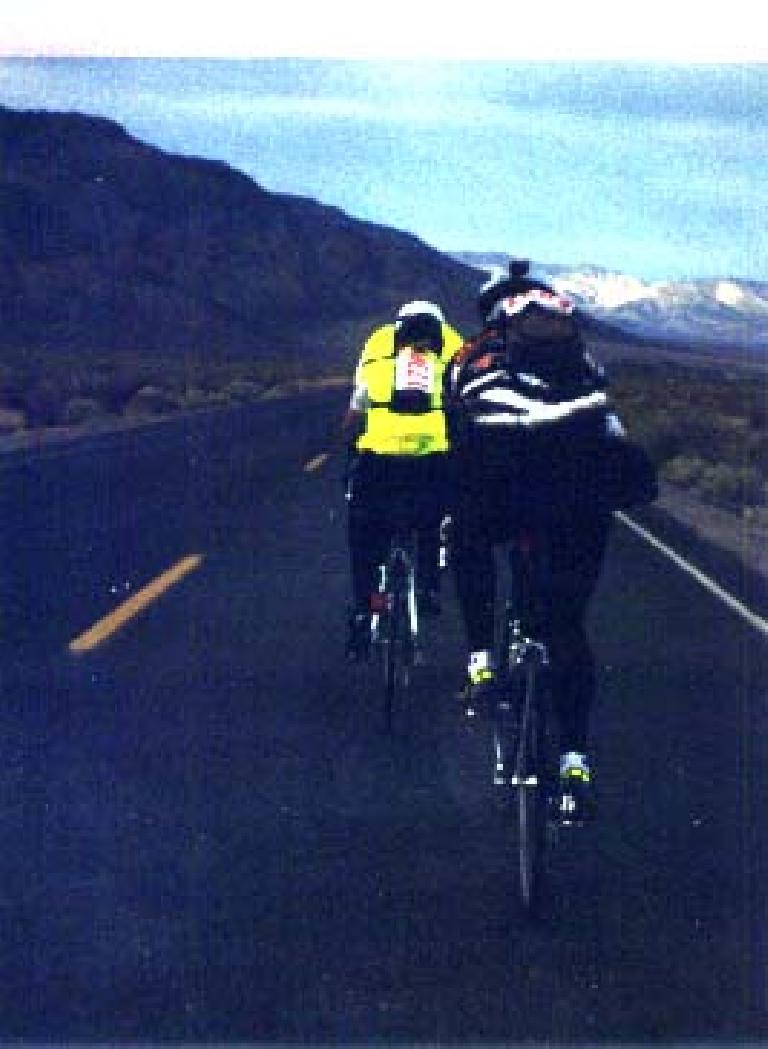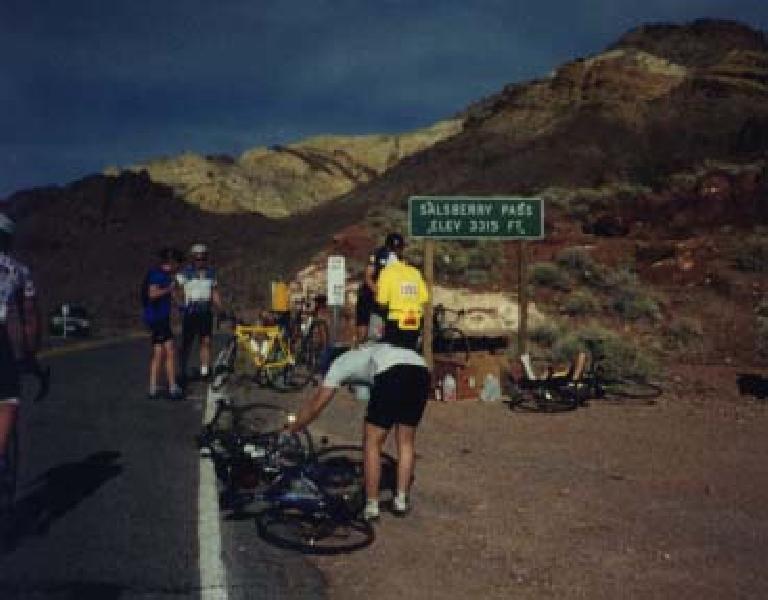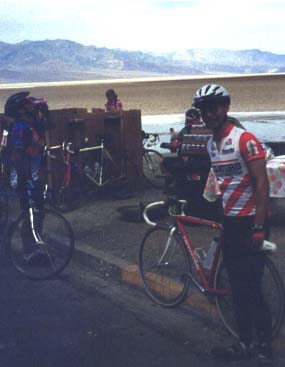Death Valley Double Century
Back in January 1997, the goal was set: the completion of three California Triple Crown events. The first was the Death Valley Double, held on March 22nd. It would be right after winter finals, and I would be in Southern California anyways to visit a Formula Mazda race car manufacturer for a potential internship and some friends. How convenient.
Supposedly, I would gradually increase my mileage to 160 miles/week, including commuting by mountain bike between my Sunnyvale home and Stanford a few days a week. As an incentive, I would also upgrade the drivetrain and wheels weeks in advance of the event so I would have sufficient time to work out all the bugs. Funny how things don’t turn out the way they’re planned…
Problems Before the Ride
Somehow, with projects, problem sets, lab reports, and interviews, I managed to ride only 50 miles/week in January, February, and March. Naturally, then, I turned my attention to the components to make up for my deficiencies.
In February I acquired a used pair of triple Shimano 105SC STI 8-speed shifters/levers and tentatively set them up with my 7-speed drivetrain. I never got the front lever to work well with my Suntour front derailleur, and finally conceded that I would have to replace the FD with the “correct” 105SC part.
So I ordered that in early March. Furthermore, I sold my old wheels and found a source of a built-up 24-spoke Mavic CXP30/Ultegra wheelset, from Florida. They would ship it right away. But I only received it on Thursday March 20—the afternoon after my last final, and the day before I planned on departing for Death Valley.
Hence, I spent all night mounting tires, cassettes, and chains, in addition to adjusting the shifting. The latter was the most frustrating part. No matter what I seemed to do, I would have to overshift 2.5 clicks in order to downshift on certain cogs. And then I stripped the threads in the anchor of the new 105SC front derailleur. I mounted the old Suntour FD, and conceded defeat with the rear derailleur. I theorized that my new Taya chain was incompatible with the 8-speed cogs.
Little training, untested equipment, 10,000 ft of climbing, high temperatures, strong winds, and a 35% dropout rate in the 1996 Death Valley Double—these were my thoughts the day before the event. Undaunted, I couldn’t help but think, this is going to be one heck of a ride.
The Drive to Death Valley: An Adventure Itself
I had a pre-conceived notion that Death Valley is close to L.A. and that it would take eight hours to drive there from the Bay Area, ten hours max. So I was surprised when I looked at distance estimates on a AAA map the day before I leave. It looked like 500 miles.
My dad wondered about the wisdom about driving a 28-year-old British car for such a trip. Surely I would not make it, he said. I replied that I had the utmost confidence in the car. Never question a half-crazy 21-year-old college student with the faith.
So on Friday, March 21, I took off at 11:00 a.m. The start of the double century was 3:30 a.m. There were three potential routes to Death Valley, none of them direct: through Lake Tahoe, Yosemite, or Bakersfied. The Yosemite route looked the shortest and the most scenic, so I initially took that route.
Mistake! Eventually I reached a roadblock on CA-120 where a friendly officer informs me that Tioga pass is closed all winter and I have to turn around. So I had to backtrack 60 miles for a total of 120 wasted miles. But I had no time to feel bad or reprimand myself for not somehow checking first.
Hours and hours passed, and despite the setback, I wasmaking good time. I was close to Bakersfield by dusk and decided to take an easterly “shortcut” via highway 155. It didn’t look like a major highway on the map, and on the road it sure was lonesome out there. I was listening to a “Best of Brian Adams” CD all the way up… and down… and up, and up, and up. This highway had some of the steepest grades I’ve ever driven on, and there were hairpin turns galore. Goldie was crawling in second gear and making lousy time. I regretted going this way.
Finally, after two hours or so (and only 60 miles), we were back on a “real” highway. I was very relieved. I drove on for a couple more hours and finally stopped at a McDonald’s to grab a bite and review my maps. I also indulged in some fries and a chicken sandwich.
It was then that I realized I forgot to bring instructions on how to get to the start of the ride. I knew it was somewhere in DV, but where?
I called the ride organizer’s number, but of course he was not answering. I had gone 500 miles and was in jeopardy of not even finding the start location.
But an idea flashed in my head… the information is on the internet, all I have to do is get in touch with someone with Web access. I start calling people at Stanford. Thankfully, my friend Nalu was there. He couldn’t find directions but gave me the phone number of the Longstreet Casino, which apparently was the start. I called and learn that this casino is actually 100 yards from the CA border, in Nevada. I owe Nalu a lot of thanks.
I finally arrived at 2:00 a.m., and it was apparently that I wouldn’t be able to sleep much, if at all, before the ride. It was kind of like the night before (three hours of sleep), and the night before that (catnaps here and there before my morning final). D’oh.

Any hopes of being able to take even a short catnap vanished upon dealing with my bicycle. First, I took off the Taya chain and replaced it with the Sachs one I picked up the day before. No problem there.
But then took the front wheel out of the trunk and its new tire was flat. I replaced it with my only spare tube, a $2.50 latex “clearance item.” One of the ride staff gave me a hand, whom I’m very grateful to. He was elderly, even-tempered, and had a MG TF.

He even tried to find the leak in my old tube, but couldn’t. So he lends me one of his tubes. “You just might need it,” he said.
After that, I still had to change clothes, register, and mount my lights. Finally, I was ready to depart at 4:00 a.m.
The Ride
Shifting seemed somewhat improved with the Sachs chain, with less chain noise, but I still needed to “triple click” to downshift into certain gears.
Nevertheless, I got into a good rhythm. A rider with Spinergy wheels and I traded pulls, and we steadily caught up to the earlier riders who left earlier. Then, at around 25 miles, things got slightly more exciting.

It was all downhill! We maintained speeds of 35-45 mph, without even pedaling. It was like that for 20 minutes, and then we got to the first rest stop.
The sun was also coming up and I was feeling good.
Miles 30-100
My strategy was to stop at most rest stops, but only long enough to fill up water bottles. I felt strong.
What happened during miles 30 to 100, I don’t really remember too well aside fom drafting off of some tandems from miles 80 to 100. They were going fast and, to avoid slowing them down, I didn’t take a turn at the front. This is bad cycling etiquette.
Eventually one of the guys on the tandem made a comment about how I was reluctant to pull, but didn’t make a big deal of it. But I felt bad about it, so after Mile 100 I hardly drafted at all.
Surprisingly, it was only 9:30 a.m. by the time I reached the 100-mile checkpoint. It only took 5:30 to do it—my fastest century by far despite conserving energy for the next 100 miles. I was feeling pretty good despite the poor preparation and training.

At the rest stop I used a Port-o-Jet for the first time during the ride. I talked with one of the riders who noticed my Stanford jersey. He was a rider from Western Wheelers in Palo Alto and inquired if I know a Stanford rider named Dan Connelly. I replied affirmatively; everyone knows Dan. It was nice to see someone from my area in this deserted part of the world.
Miles 100-135
For the next 30 miles, I rode mostly alone. With the sun shining brightly, I was getting hot so I took off my arm warmers and tights. The barren desert scenery was fully exposed, and I felt somewhat bored. I started to think of my plans for the days ahead, the people I hoped to see, etc. Suddenly I had an urge to be with some friends and felt indifferent about cycling.
“My gosh, it’s not even 11:00 and I have only 70 miles to go,” I thought. “I have 11 hours to do 70 miles since the ride officially ends at 10:00 p.m. This is not even a challenge. What happened to the sandstorms, the obnoxious winds, the steep climbs that I’ve heard so much about regarding the 1996 Death Valley Double?”
I was getting particularly cocky that despite laughable preparation and no sleep, I was so far along and was hardly tired. Tired of the repetitive desert scenery, perhaps, but not really physically tired. I was more tired in the last year’s Davis Double at this point. It was as if I had mastered ultramarathon cycling and it was time to move on to another hobby.
But almost as suddenly as I had those thoughts, fortunes began to change. First the winds pick up. The roads got hillier. I attempted to shift into my granny gear for one of the few times during the ride and the Suntour front derailleur got sucked into the chainrings.
I dismounted and tried to fix it. A magnanimous rider stopped and lent me the appropriate size hex wrench. We couldn’t figure out what is wrong, so I end up removing the entire derailleur to get it fixed by a mechanic at the next rest stop just a couple miles ahead.
But the mechanic didn’t want to attempt to fix it. I already lost a lot of time, so I left it alone. I figured, I can always dismount and shift the chain manually if I had to.
One unfortunate thing about walking around the rest stop was getting dirt into my cleats. After that, it was hard to unclip from the left pedal, and in doing so, I twisted an ankle awkwardly. It hurt for the rest of the ride.
At first I was able to handle the pain. But then came the most challenging section of the double century.
Miles 135-145
The winds started to die down again, but here were the hills I heard a little about.
Jubilee Pass is a climb of a couple thousand feet, and in 90 degree heat, it was exhausting. At least it wasn’t too long.
My left ankle was really hurting. From this point on I produced most of my power with my right leg due to the pain.
Then came Salsberry Pass. What a climb; it was so steep and hot. I squirted water on myself every few minutes.
At one point, I guessed that the top was only a few miles away and decided to grin and bear it, figuring the faster I went, the sooner the climb would be over. I didn’t realize the top was still over five miles away.
Then my rear tire started hissing. This one was an ultralight butyl tube. I knew I should have stayed away from them; I learned two years ago that those types of tubes are crap but decided to give them a shot again with the new wheels. Now I was super thankful for the extra spare tube that the gentleman lent to me before the ride.
I lost even more time now. Fortunately, one of the support vehicles came to help out and even had a floor pump.
When I got back on the bike, my legs were gone. Every few minutes I had to dismount and walk. This was really humbling and it seemed like the top would never come.
Eventually, of course, it did. Upon seeing it I had a second wind and tripled my speed, from 4 mph to 12 mph. The other riders couldn’t help but laugh at my newfound glee.
I stayed at the rest stop longer than usual, my energy being completely sapped. Psychologically, I was demoralized. With the flat tire, the walking, and the slow riding, it took two hours to go a mere six miles. That was pretty pathetic.

From Mile 145 to Mile 180
Fortunately, with every uphill there’s a downhill. I coasted all the way down because I was so drained. My ankle was really bothering me. Around mile 175, I was also really confused about directions. Fortunately, one of the support vehicles was there to help out. The support in this ride was superb: every time I had a problem, I encountered a vehicle within a few minutes.
When it started to get dark, I still had hopes to make it back by 7:00 p.m. Despite ankle pain, I had enough energy to go at a respectable pace of 18 mph.
To the End
A couple of other riders joined me and we exchanged pulls. We were moving. I was grimacing but tried to hold on as long as possible.
Eventually, one of the riders had to stop for some reason. He urged us to go on saying he’ll catch up.
I lost momentum again and my ankle was hurting enough that I resigned to a much slower pace. The rider caught up quickly and wanted to work together to catch the other guy. But I was hurting so I rode alone, watching him depart into the darkness.
By then it was totally dark and a little cold. The batteries in my front Vistalight headlamp were almost dead. I could see blinking tail lights ahead, but I really wished I could see the cycle computer so I would know how many more miles to go. It seemed like an eternity.
Once in awhile a support vehicle caught up to me and followed me for awhile, but otherwise nobody was around. This was the first time I did an organized bicycle ride in total darkness at the end.
At last, I could see lights past the Nevada Border of the Longstreet Casino. But they were still seven miles away. It was somewhat agonizing that I could clearly see them but didn’t seem to be getting any closer at any appreciable speed.
At 7:30 p.m., I arrived at the casino. I checked in, talk withed a couple of cyclists whom I met during the ride, loaded my bike, change my clothes, and put the top up on the car (it had left it covered with the tonneau cover). Done.
After the Ride
At 9:00 p.m. I was ready to leave. Yearning for a phone, a shower, and to hear the voice of some friends, I stopped by the only hotel I knew was even remotely nearby on the west side of the CA border. Of course, there were no vacancies and none of my three wishes were fulfilled.
I briefly pondered driving three hours to Bakersfield, but only got a few miles out before deciding to pull 100 feet off the road. Nothing was around—no houses, businesses, or even passing cars. This was no-man’s land, a loner’s world, a vacuous pit in grave contrast to the frenetic life of the Bay Area. Peaceful for sure. I came to Death Valley partly due to a desire to relax and to get away from it all, and this is just what happened.
Almost instantly, the stresses of the past week and the sleeplessness of the last few days melted away. There I slept, cuddled up with my plaid blanket in the inviting driver seat of my beloved MGB, only to be awoken the next morning by the rays of a hot sun that had baked me a mere 15 hours before.
Ride data
- 198 mi, through “the most beautiful desert scenery on the planet”
- 15.5 hours overall; 4:00 a.m. to 7:30 p.m.
- First half: 5h30m (19.5 mph moving average)
- Second half: 10h00m
- Max speed: 47.5 mph
- Problems encountered: broken front derailleur, two flat tires, injured left ankle
Rating
(5=best)
- Scenery: 2+
- Support/Organization: 4
- Food: 2
- Relative difficulty: 2 for all parts except for miles 130-140, which
included obnoxious headwinds, high temperatures, and a killer 3500-ft climb. I’d classify that section as a 5 in difficulty. - Overall rating: 2+. Relaxing but ho-hum in many areas and almost too challenging in one. But worth the 15-hour drive from Sunnyvale.
